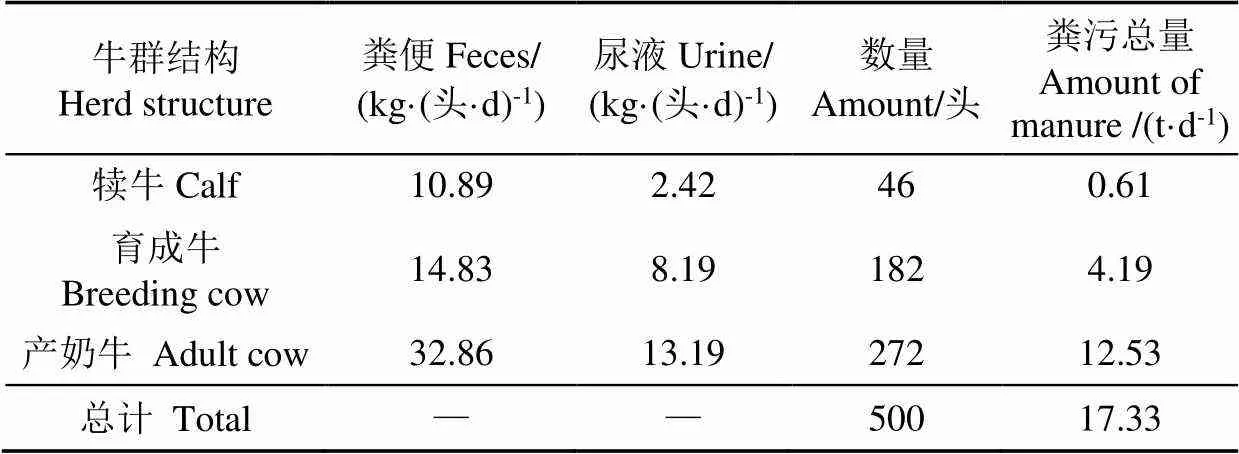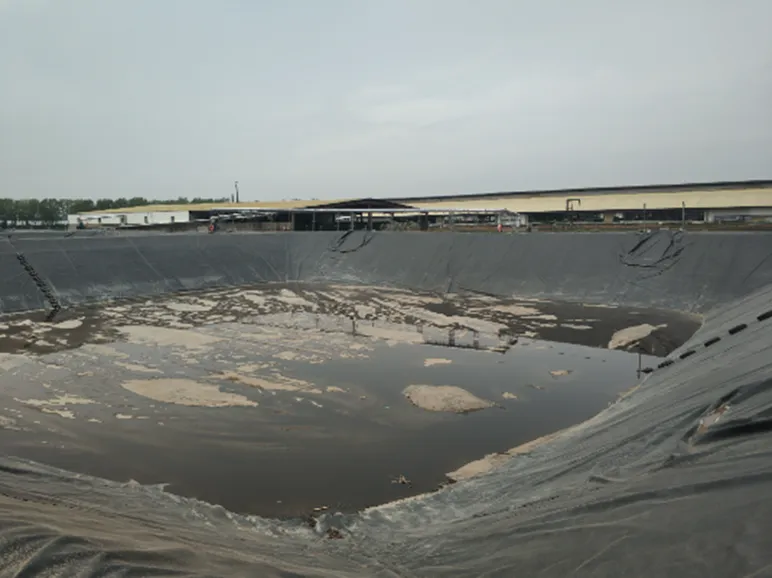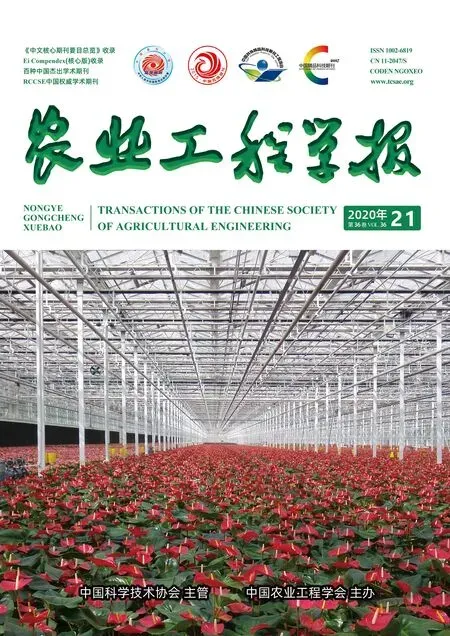规模化奶牛场粪污全量贮存及肥料化还田工艺设计
徐鹏翔,沈玉君,丁京涛,孟海波,张朋月
规模化奶牛场粪污全量贮存及肥料化还田工艺设计
徐鹏翔,沈玉君,丁京涛,孟海波※,张朋月
(农业农村部规划设计研究院农村能源与环保研究所,农业农村部资源循环利用技术与模式重点实验室,北京 100125)
为推进粪污全量贮存和肥料化还田模式在规模化奶牛场的应用,该研究以存栏500头规模奶牛场为例,分析了粪污收集量、贮存工艺与设施和粪肥还田等内容,提出了粪污贮存池设计容积和粪肥还田配套土地面积等参数。结果表明:奶牛粪污全量收集量为17.33 t/d,全量贮存设施分为舍内贮存池和舍外贮存囊2种。单个舍内贮存池尺寸为85 m×12 m×2 m(长×宽×深),粪污存储期9个月,所需贮存池数量为5个,总容积10 200 m3;舍外贮存囊占地尺寸为90 m×30 m(长×宽),深2.2 m,总容积5 615 m3。粪肥全部还田所需土地面积与种植作物类型和种植制度相关,种植作物为小麦、玉米、小麦+玉米和水稻(1年2熟)时,需配套土地分别为248.4、400.6、122.8和127.0 hm2。粪肥还田成本为10.37万元/a,全部还田可节省化肥22.8万元/a,年可产生经济效益12.43万元。
粪;贮存; 奶牛场;还田利用;工艺设计
0 引 言
据统计,2017年中国奶牛存栏量达到1 340.4万头,已成为世界第三大产奶国[1]。随着奶牛养殖规模的逐步增加,奶牛粪污处理和资源化利用也越来越受到关注。目前,奶牛粪污处理常用工艺技术有好氧堆肥、厌氧发酵、兼氧贮存和污水处理等,其中以固液分离后固体粪便进行堆肥、液体粪水经存储一定时间后还田利用工艺应用较为普遍[2-3]。
从欧美等发达国家奶牛养殖现状来看,奶牛饲养正在向适度规模和种养结合模式方向发展,粪污的最终出路以肥料化和能源化为主,规模化奶牛场的污染控制问题得到了较好的解决。据了解,法国规模化奶牛场实行种养结合和农牧一体的模式,大部分奶牛场粪污处理都采取“水泡粪全量收集+贮存后直接还田”工艺;荷兰奶牛场比较注重粪污的循环利用,粪污处理采取2种工艺,一种是“粪尿漏缝地板收集+舍内地下贮存池/舍外地上贮存池储存”工艺,另一种是“刮粪板收集+固液分离+粪便压块/粪水还田”工艺;德国侧重于支持可再生能源发展,奶牛场粪污处理主要采取秸秆与牛粪全混合沼气发酵工艺[4]。美国奶牛养殖场多数采用机械化清粪工艺,主要类型有水冲粪、水泡粪和干清粪3种,粪污通过堆肥、厌氧发酵、污水净化和生态过滤等技术处理后进行资源化利用[5]。
近年来,随着中国养殖业的规模化发展,种养分离现象逐渐严重,养殖场粪污处理量大和粪肥消纳难等问题随之出现,养殖污染已成为农业面源污染的主要来源之一。为了促进种养业健康发展,中国提出农业绿色发展之路,种养结合成为必然选择,同时养殖粪污肥料化利用也成为粪污处理的主要方向。目前,中国奶牛场普遍采用了固液分离工艺,从粪污肥料化利用角度来看,固液分离反而增加了养分的损失。现有研究表明,与粪污固液分离后固体粪便和液体粪水分别处理相比,粪污全量贮存有利于提高粪肥中养分的留存率。以奶牛粪污贮存中氮养分为例,全量粪污贮存中氮损失率为6.8%;而粪污经固液分离分别贮存时氮损失率为12.6%[6]。与全量贮存及还田相比,奶牛粪污固液分离后贮存及还田过程中的NH3损失增加了44%[7],牛粪固液分离后粪便的氨排放系数是尿液氨排放系数的1.85倍[8]。另有研究结果表明,猪粪污固液分离后存储过程中NH3损失增加了39%(冬季)和24%(夏季)[9]。
综合国内外奶牛粪污处理现状,国外以粪污全量收集贮存工艺为主,而中国以固液分离后粪便堆肥、厌氧发酵和粪水贮存等工艺应用较多。粪污全量贮存与肥料化还田作为一种粪污资源化利用的典型模式,对于种养循环发展具有重要意义,在土地匹配较充足的地区具有很好的应用前景。然而,现有关于粪污全量贮存工艺设计的研究是围绕养猪场粪污特性和设施类型展开的[10],其设计参数不适用于奶牛养殖场,且在粪肥还田量要求方面缺少数据支撑。本文重点围绕规模化奶牛场粪污全量收集、粪污贮存工艺、贮存设施设计和粪肥还田面积等方面进行分析,旨在为奶牛粪污全量收集、贮存和还田利用模式的推广应用提供参考。
1 规模化奶牛场粪污的产生与收集
1.1 粪污产生量
规模化奶牛场粪污产生量与养殖规模和牛群结构等因素相关,不同生长阶段的奶牛粪污产生量差异较大。史枢卿等[11]从牛群淘汰率角度出发研究了国内外奶牛场牛群的分布,并提出典型国内奶牛场牛群结构,以养殖规模500头为例,牛群结构为犊牛46头、育成牛182头和产奶牛272头。以此为基础,本研究对不同生长阶段的奶牛粪污产生量进行了统计,结果详见表1。

表1 规模化奶牛场粪污产生量统计[12-13]
由表1可知,以存栏500头规模奶牛养殖场为例,每天产生粪污总量为17.33 t,则全年产生粪污总量为6 325.5 t。
1.2 粪污收集
粪污全量收集通常采用漏缝地板收集工艺,该方法可随时收集粪污,起到保持牛体和卧床干净的作用。漏缝地板根据材质不同分为水泥漏缝地板、铸铁漏缝地板和塑料漏缝地板等,不同类型的漏缝地板其耐久性、舒适性和投资成本等不同。漏缝地板的缝隙比例过小会影响漏粪效果,太大容易损害牛蹄,奶牛舍漏缝地板缝隙宽设计推荐值为3.5~4.0 cm[14];同时,通过铺设配套的漏缝橡胶垫可起到增加地板柔软性和防滑效果,从而减少肢蹄损伤。与实心地板相比,漏缝地板可减少220 mg/(m2·h)的氨挥发[15],从源头节省了冲洗水的使用,粪污收集量与产生量一致。
2 粪污贮存设施参数设计
2.1 粪污贮存工艺
奶牛场粪污全量贮存是将牛舍内的粪尿通过漏缝地板收集至贮存池,经存储一定时间后进行还田利用。粪污贮存时间与环境温度相关,当环境温度≤5℃时,要求至少存储6个月;当环境温度﹥5℃时,要求至少存储4个月[16]。粪污收集后不需要固液分离,总固体含量(Total Solid,TS)一般为5%~15%。粪污贮存工艺流程如下:
2.2 贮存设施参数计算
奶牛粪污贮存设施分为舍内贮存设施和舍外贮存设施,2种设施外形和建设参数不同。舍内贮存设施具有易于粪污收集和节省占地面积的特点,但需与圈舍同时规划设计,建设成本较高,适用于新建养殖场;舍外贮存设施建设成本低,设施外形有圆形、方形和矩形等[17],场地布置灵活,可显著减少粪污存储对养殖环境的污染,适用于新建养殖场或已建养殖场。舍外贮存囊是一种经济实用的贮存设施,与圆形钢混结构贮存池相比建设成本可减少50%[18]。本研究以常用的舍内贮存池和舍外贮存囊为例,分别计算其设施设计参数。

图1 粪污全量贮存工艺流程
2.2.1 舍内贮存池
奶牛粪污舍内贮存池设置在养殖圈舍下方,池体面积与牛舍面积相同。研究表明[19-20],不同生长阶段的牛群所需要的牛舍面积不同,每头产奶牛的牛舍占地面积为8~12 m2,育成牛的牛舍占地面积为7~8 m2,犊牛的牛舍占地面积为4~5 m2。牛舍占地面积由牛舍结构和奶牛饲养数量确定,中国北方地区牛舍多采取双列式牛床布置,牛舍长度一般为82~85 m,跨度12 m,每栋约容纳100头成乳牛[21]。
奶牛粪污舍内贮存池容积计算方法如下
粪污贮存池占地面积=·(1)
式中指牛舍的长度,m;指牛舍的宽度,m。
单独舍内粪污产生量V=Q··(2)
式中Q指平均每头奶牛每天的粪污产生量,m3;指单栋舍内奶牛饲养数量,头;指粪污贮存时间,d。
粪污在舍内贮存池所需净高H= 1.2V/(3)
式中H指奶牛粪污在舍内贮存池所需净高,m;1.2指粪污产生量预留容积系数。
粪污贮存池深度=H +0.5 (4)
式中指舍内贮存池总深度,m;0.5指粪污表面与漏缝地板之间预留空间深度,m。
粪污贮存池容积pit=·(5)
式中pit指舍内贮存池容积,m3。
以100头成乳牛牛舍为例,牛舍长度取85 m,宽度取12 m,依据公式(1)可得牛舍占地面积为1 020 m2;由1.1可知每头产奶牛每天粪污产生量为46.05 kg(0.046 m3),粪污贮存时间一般要求6~9个月,此设计方案中取最大值270 d,依据公式(2)可得粪污产生总量为1 242 m3;依据公式(3)可得粪污在舍内贮存池所需净高为1.47 m;依据公式(4)可得粪污贮存池深度为1.97 m,取2.0 m。依据公式(5)可得单栋牛舍地下贮存池容积为2 040 m3,存栏500头规模奶牛场需要建设5栋牛舍,粪污贮存池总容积为10 200 m3。
2.2.2 舍外贮存囊
部分奶牛养殖场建厂时未建造舍内地下贮存池,粪污经漏缝地板或刮粪板收集后通过地下粪沟排入暂存池,再由暂存池输送至舍外贮存囊进行存储。舍外贮存囊是一种以高密度聚乙烯防渗膜(High Density Polyethylene,HDPE)为主要材料,以类似氧化塘结构为载体的粪水贮存设施,具有建设成本低、臭气控制好和安装管理方便等特点。舍外贮存囊一般采用矩形,长宽比不小于3∶1,通常以旧河道、池塘、洼地等为基础进行修建,深度不超过6 m[22]。舍外贮存囊实物图见图2。

图2 全量粪污贮存囊
舍外贮存囊容积计算方法如下:
粪污产生总量V= Q··(6)
式中指奶牛存栏量,头。
舍外贮存囊容积lagoon= 1.2V(7)
式中lagoon指舍外贮存囊容积,m3;1.2指粪污产生量预留容积系数。
以存栏500头规模奶牛养殖场为例,依据1.1和公式(6)可得每天产生粪污量为17.33 t,存储时间为270 d,则依据公式(7)可得舍外贮存囊容积为5 615 m3。依据《污水稳定塘设计规范(CJJ/T 54—93)》,给出以下设计参数供参考:承载贮存囊的塘体长取90 m,宽取30 m(长宽比3∶1),塘体深度取2.2 m(坡比2.2∶1),塘体容积为5 676 m3。
3 粪肥还田参数计算
3.1 粪肥养分含量
奶牛场粪肥养分含量因饲喂原材料、粪污收集方式和冲洗污水量等因素影响而不同[23-24],天津市27家奶牛养殖场固液分离后粪水中的总氮和总磷平均质量浓度分别为1.85和0.07 g/L[25],与全量粪肥相比养分含量较低。全量收集奶牛粪肥养分含量见表2。

表2 奶牛场全量粪污主要养分含量
由奶牛粪肥养分含量和收集率计算可知,全量粪肥中总氮含量为4.77 g/kg,总磷含量为0.86 g/kg。
3.2 粪肥还田面积
奶牛场粪肥还田面积可通过计算粪肥中氮(磷)养分总量和单位土地粪肥氮(磷)养分需求量来获得[26-27]。计算过程如下:
land=Q,p/N,p(8)
式中land指配套土地面积,hm2;Q,p指奶牛场还田利用的粪肥氮(磷)养分总量,kg/a;N,p指种植作物的单位土地粪肥氮(磷)养分需求量,kg/(hm2·a)。
Q,p=··R·T(9)
式中指畜禽粪肥氮(磷)排泄量,kg/(头·d);R指畜禽粪肥氮(磷)养分留存率,%;T指奶牛饲养时间,取值0~365 d。
N,p=N·P·P/R (10)
式中N指种植作物单位面积氮(磷)养分需求总量,kg/(hm2·a);P指作物总养分中施肥供给养分占比,%;P指畜禽粪肥养分含量占施肥总量的比例,%;R指粪肥当季利用率,%。
N= ∑ (P·Q· 10) (11)
式中P指第季种植作物的单位目标产量,t/(hm2·季);Q指第季作物形成100 kg产量吸收的氮(磷),kg。
以存栏500头规模奶牛养殖场为例,假设种植作物类型有小麦、玉米和水稻,粪肥类型为全量粪肥,分别以氮和磷养分为基准对配套土地面积进行计算,结果见表3。

表3 奶牛场全量粪肥还田配套土地面积计算
注:小麦、玉米和水稻的目标产量为4.5、6.0和6.0 t·hm-2,每形成100 kg产量需氮量为3.0、2.3和2.2 kg,每形成100 kg产量需磷量为1.0、0.3和0.8 kg;施肥供给养分占比取45%;畜禽粪肥养分含量占施肥总量的比例取50%;粪肥氮素当季利用率取25%,粪肥磷素当季利用率取30%[24]。
Note: The target production of wheat, maize and rice is 4.5, 6.0 and 6.0 t·hm-2respectively; The amount of nitrogen demand for each 100 kg yield of wheat, corn and rice is 3.0, 2.3 and 2.2 kg; The amount of phosphorus demand for each 100 kg yield of wheat, corn and rice is 1.0, 0.3 and 0.8 kg; The proportion of nutrients supplied by fertilizer is 45%; The proportion of manure nutrient content to the nutrient of all the fertilizers is 50%; The utilization rate of nitrogen from manure in the current season is 25%; The utilization rate of phosphorus from manure in the current season is 30%.
由表3数据可知,当作物种植类型和种植制度不同时,全量粪肥还田所需要配套的土地面积不同。为防止粪肥过量施用,配套土地面积应取以氮和磷为基准计算结果的较高值。奶牛场全量粪肥还田时,若种植作物为小麦(1年1熟),则需要配套土地248.4 hm2;若种植作物为玉米(1年1熟),则需要配套土地400.6 hm2;若种植作物为小麦和玉米(1年2熟),则需要配套土地122.8 hm2;若种植作物为水稻(1年2熟),则需要配套土地127.0 hm2。
3.3 粪肥施用成本与效益
粪肥施用成本包括粪污收集与施用过程中的人工费、电费和运输费。以存栏500头规模奶牛场为例,全量粪肥施用成本为10.37万元/a,各项费用详见表4。

表4 奶牛场全量粪肥年施用成本
经计算,存栏500头奶牛养殖场每年产生的全量粪肥中氮养分含量可折算尿素量为130 t,磷养分含量可折算过磷酸钙量为8.9 t,若尿素和过磷酸钙价格分别以1 700元/t和800元/t计,则粪肥全部还田可折合节省化肥22.8万元。综上所述,存栏500头奶牛养殖场采用粪污全量贮存与肥料化还田工艺时,每年可产生经济效益12.43万元。
4 结 论
1)奶牛场粪污全量贮存及肥料化还田模式可从源头节省用水,简化粪污处理流程,提高粪肥中养分的留存率,在种养结合和循环农业发展中具有较好的应用前景。该研究从粪污全量贮存和肥料化还田工艺设计角度出发,提出了粪污收集量、贮存设施类型与容积、粪肥养分含量和配套土地面积等参数和计算方法,为粪污全量贮存和粪肥还田提供了参考。
2)常用的粪污全量贮存设施分为舍内贮存池和舍外贮存囊2种,舍内贮存池适用于新建养殖场;舍外贮存囊适用于新建或已建养殖场,养殖场可根据场地面积、投资费用和周边环境等条件选择适宜的设施类型。以存栏500头奶牛场为例,共需5个舍内贮存池,建设总容积为10 200 m3,而舍外贮存囊所需总容积为5 615 m3。
3)粪肥还田土地面积与粪肥中氮(磷)养分含量、土壤养分背景值、种植作物类型和种植制度等因素相关。存栏500头奶牛场粪肥全部还田,每年种植作物分别为小麦、玉米、小麦和玉米、水稻(1年2熟)时,需配套相应的土地面积为248.4、400.6、122.8 和127.0 hm2。粪肥还田成本为10.37万元/a,全部还田可节省化肥22.8万元/a,年可产生经济效益12.43万元。
[1] 樊斌,薛晓聪,李萌,等. 中国奶牛养殖生产布局优化研究:基于比较优势的实证分析[J]. 农业现代化研究,2020,41(2):331-340. Fan Bin, Xue Xiaocong, Li Meng, et al. Production layout optimization of dairy farming in China: An empirical analysis based on comparative advantage[J]. Research of Agricultural Modernization, 2020, 41(2): 331-340. (in Chinese with English abstract)
[2] 施正香,王盼柳,张丽,等. 我国奶牛场粪污处理现状与综合治理技术模式分析[J]. 中国畜牧杂志,2016,52(14):62-66. Shi Zhengxiang, Wang Panliu, Zhang Li, et al. State of dairy waste treatment and comprehensive management mode in China[J]. Chinese Journal of Animal Science, 2016, 52(14): 62-66. (in Chinese with English abstract)
[3] 罗娟,赵立欣,姚宗路,等. 规模化养殖场畜禽粪污处理综合评价指标体系构建与应用[J]. 农业工程学报,2020,36(17): 182-189. Luo Juan, Zhao Lixin, Yao Zonglu, et al. Construction and application of comprehensive evaluation index system for waste treatment on intensive livestock farms[J]. Transactions of the Chinese Society of Agricultural Engineering (Transactions of the CSAE), 2020, 36(17): 182-189.(in Chinese with English abstract)
[4] 李孟娇,董晓霞,李宇华. 发达国家奶牛规模化养殖的粪污处理经验:以欧盟主要奶业国家为例[J]. 世界农业,2014,5:10-15.
[5] 李孟娇,董晓霞,郭江鹏. 美国奶牛规模化养殖的环境政策与粪污处理模式[J]. 生态经济,2014,30(7):55-59. Li Mengjiao, Dong Haixia, Guo Jiangpeng. The environment policy and manure treatment models of large-scale milk cows breeding in US[J]. Ecological Economy, 2014, 30(7): 55-59. (in Chinese with English abstract)
[6] Perazzolo F, Mattachini G, Tambone F, et al. Nutrient losses from cattle co-digestate slurry during storage[J]. Journal of Agricultural Engineering, 2016, 47(2): 94-99.
[7] Dinuccio E, Berg W, Balsari P. Effects of mechanical separation on GHG and ammonia emissions from cattle slurry under winter conditions[J]. Animal Feed Science and Technology, 2011, 166: 532–538.
[8] 美英,魏坤昊,崔钠淇,等. 集约化奶牛养殖场不同粪尿处理阶段氮素分布及氨排放特征[J]. 农业工程学报,2018,34(18): 261-267. Mei Ying, Wei Kunhao, Cui Naqi, et al. Nitrogen distribution and ammonia emission characteristics in different livestock manure treatment processes in intensive dairy farms[J]. Transactions of the Chinese Society of Agricultural Engineering (Transactions of the CSAE), 2018, 34(18): 261-267.(in Chinese with English abstract)
[9] Dinuccio E, Gioelli F, Balsari P, et al. Ammonia losses from the storage and application of raw and chemo-mechanically separated slurry[J]. Agriculture, Ecosystems and Environment, 2012, 153: 16-23.
[10] 徐鹏翔,沈玉君,丁京涛,等. 规模化养猪场粪污全量收集及贮存工艺设计[J]. 农业工程学报,2020,36(9): 255-262. Xu Pengxiang, Shen Yujun, Ding Jingtao, et al. Slurry manure collection and design of storage system on scaled pig farms[J]. Transactions of the Chinese Society of Agricultural Engineering (Transactions of the CSAE), 2020, 36(9): 255-262.(in Chinese with English abstract)
[11] 史枢卿,李守忠. 关于奶牛场设计和建设的奶牛体尺、牛群结构标准参数[J]. 中国奶牛,2006,1:47-50.
[12] 杨前平,李晓锋,熊琪,等. 奶牛场粪污产生量及性能参数测定[J]. 湖北农业科学,2019,58(24):106-108,119. Yang Qianping, Li Xiaofeng, Xiong Qi, et al. Determination of feces production and performance parameters in dairy farm[J]. Hubei Agricultural Sciences, 2019, 58(24): 106-108, 119. (in Chinese with English abstract)
[13] 中国农业科学院农业环境与可持续发展研究所,环境保护部南京环境科学研究所. 第一次全国污染源普查畜禽养殖业源产排污系数手册[Z]. 北京:国务院第一次全国污染源普查领导小组办公室,2009.
[14] 刘继军,贾永全. 畜牧场规划设计[M]. 北京:中国农业出版社,2008:237-283.
[15] 赵润,张蕙杰,刘琦,等. 欧盟奶业环境污染防治经验-以集约化奶牛场粪水管控为例[J]. 环境保护,2019,9:69-74.
[16] Manyi-Loh C E, Mamphweli S N, Meyer E L, et al. An overview of the control of bacterial pathogens in cattle manure[J]. International Journal of Environmental Research and Public Health, 2016, 13(9): 1-27.
[17] Aboltins A, Priekulis J, Aboltina B, et al. Effect of slurry lagoon redesign on reduction of ammonia emission during livestock manure storage[J]. Agronomy Research, 2017, 15(5): 1822-1830.
[18] Priekulis J, Murikov V. Research in liquid manure removal and storage technological versions on milk farms[J]. Agronomy Research, 2008, 6(Special issue): 299-306.
[19] 张靖静,柳玉华,陈杭. 我国南方地区中小型奶牛场设计Ⅱ.牛舍、运动场等建筑设计[J].江苏农业科学,2003,2:49-52.
[20] 尤震晨,胥磊,黄锡霞,等. 新疆北疆地区奶牛场建设与粪污处理情况分析[J]. 家畜生态学报,2019,40(1):60-64. You Zhenchen, Xu Lei, Huang Xixia, et al. Analysis on dairy farm construction and manure treatment in northern Xinjiang[J]. Acta Ecologiae Animalis Domastici, 2019, 40(1): 60-64. (in Chinese with English abstract)
[21] 刘海源. 我国北方地区工厂化奶牛场设计研究[D]. 哈尔滨:哈尔滨工业大学,2009. Liu Haiyuan. The Research of the Factory-dairy Farm Design in Northern China[D]. Harbin: Harbin Institute of Technology. 2009. (in Chinese with English abstract)
[22] 中华人民共和国国家质量监督检验检疫总局中国国家标准化管理委员会. 畜禽养殖污水贮存设施设计要求:GB/T26624—2011[S]. 北京:中国标准出版社.
[23] 赵润,杨仁杰,牟美睿,等. 基于中红外光谱的规模化奶牛场粪水总氮快速预测方法[J]. 农业工程学报,2019,35(15): 217-224. Zhao Run, Yang Renjie, Mou Meirui, et al. Rapid prediction method of total nitrogen in slurry of large-scale dairy farm by mid-infrared spectroscopy[J]. Transactions of the Chinese Society of Agricultural Engineering (Transactions of the CSAE), 2019, 35(15): 217-224.(in Chinese with English abstract)
[24] 张帅,陆鹏,陈硕,等. 京郊畜禽粪污氮磷含量特征及影响因素分析[J]. 农业工程学报,2018,34(8): 244-251. Zhang Shuai, Lu Peng, Chen Shuo, et al. Characteristics of nitrogen and phosphorus content and analysis of its influencing factors in feces and wastewater of livestock farms in Beijing suburb[J]. Transactions of the Chinese Society of Agricultural Engineering (Transactions of the CSAE), 2018, 34(8): 244-251.(in Chinese with English abstract)
[25] 孙迪,杨仁杰,李梦婷,等. 春秋季对近红外光谱模型预测奶牛场粪水氮磷含量结果的影响[J]. 农业工程学报,2020,36(10): 197-205. Sun Di, Yang Renjie, Li Mengting, et al. Influences of spring and autumn on the nitrogen and phosphorus contents of the slurry predicted by near-infrared spectrum model on dairy farms[J]. Transactions of the Chinese Society of Agricultural Engineering (Transactions of the CSAE), 2020, 36(10): 197-205.(in Chinese with English abstract)
[26] 全国畜牧总站中国饲料工业协会国家畜禽养殖废弃物资源化利用科技创新联盟. 土地承载力测算技术指南[M]. 北京:中国农业出版社,2017.
[27] 韩成吉,王国刚,朱立志. 畜禽粪污土地承载力系统动力学模型及情景仿真[J]. 农业工程学报,2019,35(22): 170-180. Han Chengji, Wang Guogang, Zhu Lizhi. System dynamic model and scenario simulation of land carrying capacity for livestock and poultry manure[J]. Transactions of the Chinese Society of Agricultural Engineering (Transactions of the CSAE), 2019, 35(22): 170-180.(in Chinese with English abstract)
Technological design of slurry manure storage and returning to farmland for fertilization on large-scale dairy farm
Xu Pengxiang, Shen Yujun, Ding Jingtao, Meng Haibo※, Zhang Pengyue
(,,,,,100125,)
In order to promote the healthy development of animal husbandry, China put forward the road of green development of agriculture. The combination of planting and breeding has become an inevitable choice. The utilization of manure back to farmland is an important way of waste treatment in dairy farms. There are three types of manure, including solid, liquid, and slurry manure, which can be used as organic fertilizers. At present, returning of solid manure (after composting) and liquid manure (after storage or anaerobic fermentation) to the cropland has become the main way in dairy farms in China, while the slurry manure (after storage) is widely used in developed countries, such as Europe and America. Compared to other types of manure, the slurry manure contained higher nutrient, showing a promising application prospect in the areas with sufficient farmland. The storage technology of slurry manure has some good characteristics, such as easy collection of excrement, saving storage areas, and low treatment cost. However, only a few application cases were realized in China. In this study, the following contents were investigated for the technological design of manure storage, including the amount of collected manure wastes, parameters of storage facilities, parameters of manure utilization to farmland, costs of operation and so on,the volume of slurry manure storage facilities and the matching land areas of manure returning to farmland were given at the end. The results showed that the obvious advantages can be found in the slurry manure technology. A scaled farm with 500 dairy cattle was taken as an example, where the amount of slurry manure was 17.33 t per day. There are two types of slurry manure storage facilities, under-floor storage pit inside the breeding house and manure storage lagoon outside. The length, width, and depth of one under-floor storage pit were 85, 12 and 2 m, respectively, which can meet the storage need of slurry manure produced during 9 months. In the scaled farm with 500 dairy cattle, it needed 5 under-floor storage pits, where the total volume was 10 200 m3. The length, width, and depth of one manure storage lagoon were 90, 30 and 2.2 m, respectively, with a total volume of 5 615 m3, which can meet the storage need of slurry manure produced during 9 months. The farmland area for the application of manure was closely related to crop species and planting system. If the planting crops were wheat, harvest once a year, 248.4 hm2of farmland was needed for manure application. If the planting crops were corn, harvest once a year, 400.6 hm2of farmland was needed for manure application. If the planting crops were wheat and corn, harvest twice a year, 122.8 hm2of farmland was needed for manure application. If the planting crops were rice, harvest twice a year, 127.0 hm2of farmland was needed for manure application. The cost of all slurry manure returning to farmland was 103.7 thousand yuan, saving about 228 thousand yuan a year, compared with that of chemical fertilizers, and the annual economic benefit is 124.3 thousand yuan. The finding can provide a potential support for the application of storage technology for slurry manure.
manure; storage; dairy farms; farmland utilization; technological design
徐鹏翔,沈玉君,丁京涛,等. 规模化奶牛场粪污全量贮存及肥料化还田工艺设计[J]. 农业工程学报,2020,36(21):260-265. doi:10.11975/j.issn.1002-6819.2020.21.031 http://www.tcsae.org
Xu Pengxiang, Shen Yujun, Ding Jingtao, et al. Technological design of slurry manure storage and returning to farmland for fertilization on large-scale dairy farm[J]. Transactions of the Chinese Society of Agricultural Engineering (Transactions of the CSAE), 2020, 36(21): 260-265. (in Chinese with English abstract) doi:10.11975/j.issn.1002-6819.2020.21.031 http://www.tcsae.org
2020-06-30
2020-09-23
农业农村部规划设计研究院自主研发项目:畜禽养殖粪水酸化贮存及施用技术研究(2018ZZYF0101)
徐鹏翔,博士,高级工程师,主要从事农业废弃物资源化利用研究。Email:xpx527@126.com
孟海波,博士,研究员,主要从事农业废弃物资源化利用研究。Email:newmhb7209@163.com
10.11975/j.issn.1002-6819.2020.21.031
X713
A
1002-6819(2020)-21-0260-06

